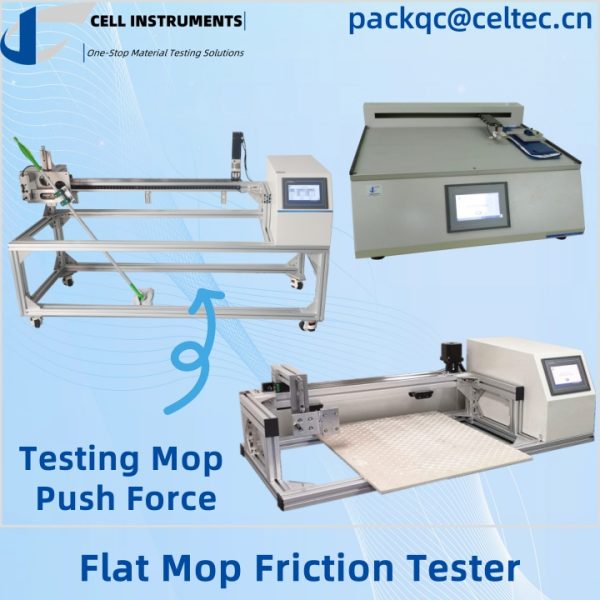Flat Mop Friction Test: Analyzing Mop Push Force for Optimal Cleaning Efficiency
In the cleaning industry, ensuring that flat mops are efficient and easy to use is crucial. One of the primary ways to evaluate the performance of a mop is through a flat mop friction test, which measures the resistance or friction the mop experiences when pushed across a surface. Understanding how much effort is required to move the mop, often referred to as testing mop push force, can significantly impact product design, user experience, and overall cleaning efficiency.
The Importance of Flat Mop Friction Testing
The flat mop friction test plays a vital role in determining how effective a mop will be in real-world applications. A mop with high friction may require more effort to use, leading to user fatigue. Conversely, low friction could mean the mop is not cleaning effectively. Testing the friction also helps in understanding how the mop material interacts with various surfaces such as tile, wood, and glass.
In addition, mop push force testing is essential in evaluating how much physical exertion is needed to operate the mop effectively. This data provides valuable insights for manufacturers looking to improve product ergonomics and design.
How the Flat Mop Friction Test is Conducted
To perform the flat mop friction test, specialized equipment like the Mop Friction Testing Machine from Cell Instruments is used. The machine simulates the action of pushing a mop across a surface under controlled conditions. Here’s how the process works:
- Securing the Mop Sample: The mop is attached securely to the testing apparatus.
- Setting Test Parameters: The operator sets the speed, pressure, and number of cycles the mop will go through.
- Running the Test: The machine pushes the mop across a surface, and sensors measure the friction and push force.
- Recording Data: Data, such as resistance and the force required to move the mop, is captured in real-time and analyzed.
This process provides crucial information on how well the mop performs under various conditions, including wet and dry surfaces.
Key Parameters in Mop Friction Testing
There are several important parameters measured during a flat mop friction test:
- Friction Force: This is the resistance the mop experiences when being pushed across the test surface. The lower the friction force, the easier it is to use the mop.
- Push Force: The physical force needed to move the mop. Testing mop push force ensures that the mop is not too difficult to operate.
- Durability: The test can also reveal how long a mop will last by simulating repeated use over time.
By analyzing these parameters, manufacturers can make data-driven decisions about their product design, improving both performance and user experience.
Benefits of Mop Friction Testing for Manufacturers
- Product Development and Innovation: Data from the test helps in creating more efficient mops with optimized materials and designs.
- Improved Customer Satisfaction: A product that requires less effort to use while maintaining high cleaning efficiency is likely to receive better customer feedback.
- Quality Assurance: Manufacturers can ensure that their mops meet specific performance standards, which is critical for building brand reputation and customer trust.
Applications of Flat Mop Friction Testing
The flat mop friction test is particularly useful for various industries, including:
- Home Cleaning: Ensuring that mops provide adequate cleaning with minimal effort in domestic environments.
- Commercial Cleaning: Industrial-strength mops used in offices, hospitals, and factories must perform efficiently over extended periods.
- Medical and Pharmaceutical Cleaning: Mops used in sterile environments must meet strict hygiene standards, where friction and cleaning efficiency are critical.
Cell Instruments Mop Friction Testing Machine
For companies seeking reliable and precise testing, Cell Instruments’ Mop Friction Testing Machine offers the ideal solution. The device provides real-time data on friction force, push force, and other key performance indicators, making it easier for manufacturers to meet industry standards. Equipped with a PLC-controlled system and an intuitive 7-inch touch screen, this machine ensures that testing is both accurate and user-friendly. The adjustable testing speed and real-time data display also allow for a comprehensive evaluation of different mop materials and designs.
Customization and Flexibility
The Mop Friction Testing Machine by Cell Instruments offers customization options to meet unique testing needs. Whether a company needs software modifications, specific testing programs, or custom fixtures for mop samples, the machine can be adapted to ensure accurate and relevant testing.
FAQ
What is a flat mop friction test? A flat mop friction test measures the resistance a mop encounters when pushed across various surfaces, helping manufacturers improve cleaning efficiency and product design.
Why is testing mop push force important? Testing mop push force evaluates how much effort is required to use the mop, providing essential data for enhancing user ergonomics and reducing fatigue.
What equipment is used for flat mop friction testing? Specialized machines like the Cell Instruments Mop Friction Testing Machine are used to simulate mop movement and measure friction force and push force.
Can the Mop Friction Testing Machine be customized? Yes, Cell Instruments offers customization options, including software adjustments and specialized fixtures, to meet specific testing requirements.
How does friction testing improve product quality? Friction testing provides insights into the mop’s performance, allowing manufacturers to optimize materials and designs for better cleaning results.

